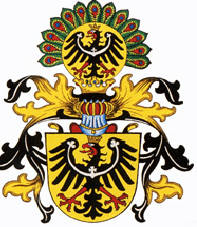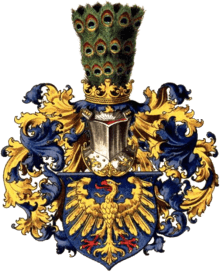Duchy of Teschen
| Duchy of Teschen | ||||||||||
| Księstwo Cieszyńskie (pl) Těšínské knížectví (cs) Herzogtum Teschen (de) Ducatus Tessinensis (la) | ||||||||||
| Silesian duchy Fiefdom of the Kingdom of Bohemia (1327) and the Bohemian Crown (1348) | ||||||||||
| ||||||||||
|
| ||||||||||
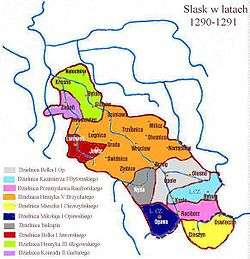 Silesia 1290-91: Duchy of Cieszyn (yellow) under Mieszko I | ||||||||||
| Capital | Cieszyn | |||||||||
| Languages | Latin (officially) German (later) Polish (popularly) Czech | |||||||||
| Religion | Roman Catholicism Protestantism | |||||||||
| Government | Principality | |||||||||
| Dukes | ||||||||||
| • | 1290–1315 | Mieszko I (first duke) | ||||||||
| • | 1625-1653 | Elizabeth Lucretia (last Piast ruler) | ||||||||
| • | 1895–1918 | Archduke Frederick Habsburg (last duke) | ||||||||
| History | ||||||||||
| • | Partitoned from Racibórz | 1290 | ||||||||
| • | Split off Oświęcim | 1315 | ||||||||
| • | Vassalized by Bohemia | 1327 | ||||||||
| • | Split off Bielsko | 1572 | ||||||||
| • | Habsburg rule | 1653 | ||||||||
| • | Part of Austrian Silesia | 1742 | ||||||||
| • | Spa Conference | 28 July 1920 | ||||||||
| Population | ||||||||||
| • | 1910 est. | 350,000 | ||||||||
| ||||||||||
| ¹ Coat of arms of the Duchy of Teschen and the regional branch of the Piast dynasty | ||||||||||
The Duchy of Teschen (German: Herzogtum Teschen), also Duchy of Cieszyn (Polish: Księstwo Cieszyńskie) or Duchy of Těšín (Czech: Těšínské knížectví, Latin: Ducatus Tessinensis) was an autonomous Silesian duchy centered on Cieszyn (Teschen) in Upper Silesia. During the feudal division of Poland it was split off from the Duchy of Racibórz in 1281 and ruled by Silesian dukes of the Piast dynasty from 1290.[1]
The ducal lands initially comprised former Lesser Polish territories east of the Biała River, which in about 1315 again split off as the Duchy of Oświęcim, while the remaining duchy became a Bohemian fief in 1327. After the bulk of Silesia was conquered by the Prussian king Frederick the Great in 1742, Cieszyn/Těšín together with the duchies of Troppau (Opava), Krnov and Nysa remained with Austrian Silesia. The ducal title was held by the Austrian archdukes of the House of Lorraine until 1918.
History
The duchy shared the history of the Cieszyn Silesia region, and also in part that of Silesia in general. The area had been the south-easternmost part of the medieval Duchy of Silesia, established upon the death of the Polish duke Bolesław III Wrymouth in 1138. In 1172 the sons of the first Silesian Piast duke Władysław II the Exile divided their heritage: the lands of Cieszyn fell to Duke Mieszko I of Racibórz.
Mieszko himself in 1202 occupied the neighbouring Duchy of Opole, forming the united Upper Silesian Duchy of Opole and Racibórz. After the death of Mieszko's grandson Duke Władysław of Opole in 1281, Upper Silesia was again divided among his sons, and the eldest, Mieszko, became the first Duke of Cieszyn in 1290.
Piast rule
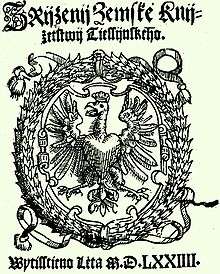
After Mieszko's death in 1315, his eldest son Władysław took the Cieszyn lands east of the Biała River and established the Duchy of Oświęcim. The younger son Casimir I retained the western part and in 1327 swore homage to the King of Bohemia, John of Luxembourg. After that Cieszyn became an autonomous fiefdom of the Kingdom of Bohemia, later the Crown of Bohemia.[2] Local Piast rulers often possessed other lands outside the Duchy of Těšín itself, for example the Duchy of Siewierz, half of Głogów and some parts of Bytom.
After the death of Duke Boleslaus I in 1431, the rule over the duchy was shared by his wife Eufemia and their four sons.[3] In 1442 the duchy was divided between sons who were all formally Dukes of Těšín, but the real control over the duchy passed to Boleslaus II and Przemyslaus II, who after the death of Boleslaus II in 1452 ruled alone. During the reign of Duke Wenceslaus III Adam, from 1528 onwards, the duchy shifted to Protestantism according to the cuius regio, eius religio rule. His son and successor Adam Wenceslaus shifted back to Roman Catholicism in 1610. In 1570s the duke struggled with financial problems and had to sell most of the towns as state countries, including Bielsko state country.
The Cieszyn Piast rule continued until 1653, ending with the death of the last scion Duchess Elizabeth Lucretia, after which the duchy passed directly to the Bohemian monarchs,[4] at that time the Habsburg emperor Ferdinand III and his son King Ferdinand IV.
Habsburg rule
The Habsburg dynasty ruled Teschen from 1653. In 1722 Emperor Charles VI of Habsburg granted it to Duke Leopold of Lorraine in compensation for his maternal grandmother's rights to the north Italian Duchy of Montferrat, which the emperor had taken and given to the Dukes of Savoy in 1708 as part of their alliance pact. Leopold's son Emperor Francis I of Habsburg-Lorraine later gave it to his eldest surviving daughter, Maria Christina, who in 1766 married Prince Albert of Saxony, who thus became known colloquially as the Duke of Saxe-Teschen.
Although most of Silesia had passed to the Kingdom of Prussia in 1742 after the First Silesian War, Teschen remained under Austrian control as part of Austrian Silesia. Albert's and Maria Christina's marriage remained childless, and upon the death of the widowed Albert in 1822 the duchy passed to their adopted son, Archduke Charles of Austria, who became Herzog von Teschen and started the Teschen branch of the Habsburg-Lorraine dynasty. The title passed down his line, first to his eldest son, Albert Frederick, and then in 1895 to Albert Frederick's nephew, Archduke Frederick Maria.
With Austrian Silesia, the territory of Teschen became part of the Austrian Empire in 1804 and a Cisleithanian crown land of Austria–Hungary in 1867. At the end of World War I the duchy was disestablished with the dissolution of Austria-Hungary.
Aftermath
Local Polish and Czech self-governments were established in the territory of Cieszyn, which on 5 November 1918 signed an interim agreement under which the territory – including the town of Cieszyn itself – was divided along the Olza (Olše, Olsa) River. The convention however failed to settle the border conflict between the newly established state of Czechoslovakia and the Second Polish Republic, which claimed further areas of the former Cieszyn duchy with a predominantly Polish-speaking population. The ongoing conflict escalated when Czechoslovak troops crossed the Olza on 23 January 1919, starting the Polish–Czechoslovak War.
Clashes of arms continued until 31 January, but neither of the belligerents benefited: at the 1920 Spa Conference the division of the former duchy along the Olza was confirmed. The eastern part of Cieszyn Silesia was incorporated into the Polish Autonomous Silesian Voivodeship, while the western part (including the Zaolzie region) became part of Czechoslovakia. This was confirmed on 5 August 1920 by the Conference of Ambassadors.[5] In 1945 the German population was expelled.
Demographics
 1910 Austrian census - percentage of Polish-speaking population
1910 Austrian census - percentage of Polish-speaking population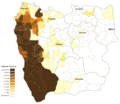 1910 Austrian census - percentage of Czech-speaking population
1910 Austrian census - percentage of Czech-speaking population 1910 Austrian census - percentage of German-speaking population
1910 Austrian census - percentage of German-speaking population
According to the Austrian census taken in 1910, the duchy had about 350,000 inhabitants: 54.8% Polish-speaking, 27.1% Czech-speaking and 18.1% German-speaking.[6]
Dukes of Teschen
Silesian Piasts
- 1290–1315 Mieszko I
- 1315–1358 Casimir I, son, swore homage to King John of Bohemia in 1327
- 1358–1410 Przemyslaus I Noszak, son
- 1410–1431 Boleslaus I, son
- 1431–1442 Euphemia of Masovia, his widow, as regent for her minor sons:
- 1431–1442 Wenceslaus I, became Duke of Siewierz and Bielsko
- 1431–1442 Wladislaus, Duke of Głogów
- 1431–1452 Boleslaus II
- 1431–1477 Przemyslaus II
- 1477–1528 Kazimierz II
- 1518–1524 Wenceslaus II, son, co-ruler with his father
- 1528–1579 Wenceslaus III Adam, son of Wenceslaus II
- 1579–1617 Adam Wenceslaus, son
- 1617–1625 Frederick William, son, left no male heirs
- 1625–1653 Elizabeth Lucretia, sister.
Reversion to the Lands of the Bohemian Crown, ruled by the House of Habsburg since 1526.
Habsburg dynasty

- 1653–1657 Ferdinand III
- 1653–1654 Ferdinand IV, son, co-ruler with his father
- 1657–1705 Leopold I
- 1705–1711 Joseph I
- 1711–1722 Charles II (Emperor Charles VI)
In 1722 Emperor Charles VI vested his nephew Leopold of Lorraine with the ducal title.
House of Habsburg-Lorraine
- 1722–1729 Leopold Joseph of Lorraine
- 1729–1765 Francis I Stephen, son, husband of Maria Theresa, Holy Roman Emperor from 1745
- 1765–1766 Emperor Joseph II, son
- 1766–1797 Archduchess Maria Christina of Austria
- 1766–1822 Prince Albert Casimir of Saxony, husband
- 1822–1847 Archduke Charles of Austria, adoptive son
- 1847–1895 Archduke Albert of Austria, son
- 1895–1918 Archduke Frederick of Austria, nephew, ousted.
Old maps
 The Duchy of Teschen: 17th/18th century map by Matthäus Seutter
The Duchy of Teschen: 17th/18th century map by Matthäus Seutter The Duchy of Teschen in 1724, by Jonas Nigrinus
The Duchy of Teschen in 1724, by Jonas Nigrinus The Duchy of Teschen in 1736, by Matthaeus Schubarth
The Duchy of Teschen in 1736, by Matthaeus Schubarth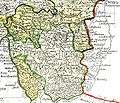 The Duchy of Teschen. 1746 map by Johann Homann
The Duchy of Teschen. 1746 map by Johann Homann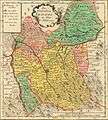 17th/18th century map of the Duchy of Teschen by Joh David Schleuen
17th/18th century map of the Duchy of Teschen by Joh David Schleuen Polish map of the Duchy of Cieszyn, 20th century
Polish map of the Duchy of Cieszyn, 20th century
Footnotes
References
- Biermann, Gottlieb (1894). Geschichte des Herzogthums Teschen (in German) (2nd ed.). Teschen: Verlag und Hofbuchhandlung Karl Prochaska. OCLC 34926439.
- Nowak, Krzysztof (2008). "Polskość i ruch narodowy". In Krzysztof Nowak. Pierwsza Niepodległość. Cieszyn: Urząd Miejski Cieszyn. pp. 7–17. ISBN 978-83-89835-40-6.
- Panic, Idzi (2002). Poczet Piastów i Piastówien cieszyńskich (in Polish). Cieszyn: Urząd Miejski. ISBN 83-917095-4-X. OCLC 55650394.
- Žáček, Rudolf (2004). Dějiny Slezska v datech. Praha: Libri. ISBN 80-7277-172-8.
External links
| Wikimedia Commons has media related to Duchy of Teschen. |
Coordinates: 49°44′59″N 18°37′46″E / 49.749767°N 18.629392°E


